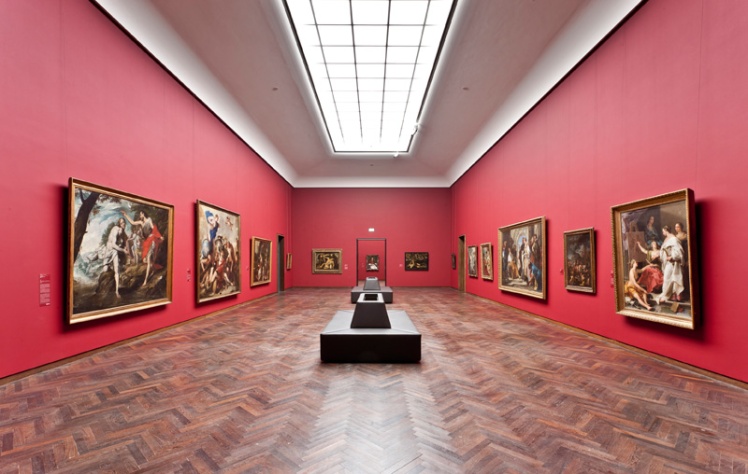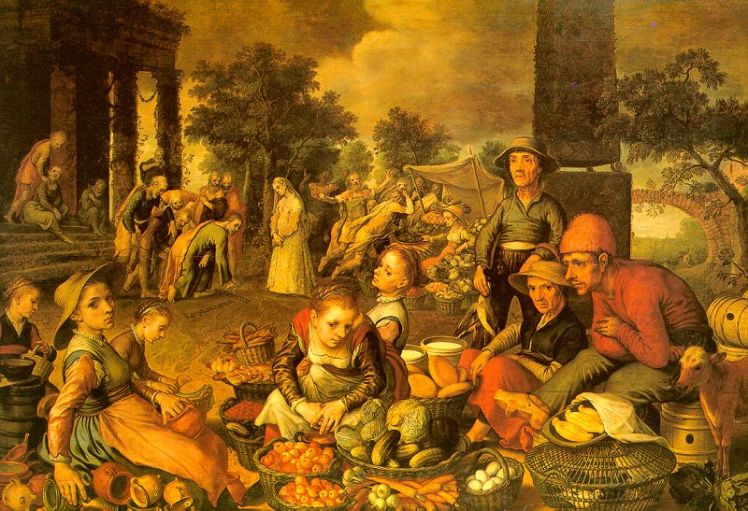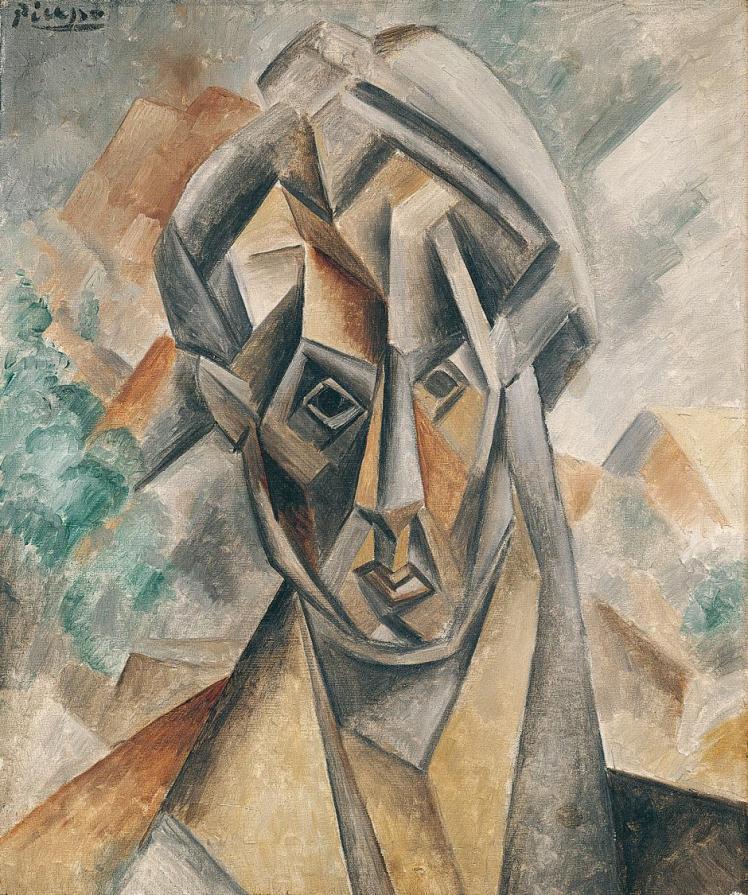
I have already posted three posts on the Staedel on my other blog (which deals with everything but travel), but since it was a place that I visited on my journeys through Europe I felt that I should probably share my experiences here as well for those who don’t read (or know about) my other blog (though I’ll place a link to the posts below as well).
Even though I’ve been to Frankfurt before I hadn’t actually know about the Staedel, or even about the collection of Museums that line the south banks of the Main. However, during my preparations (namely pouring over Google Maps) I discovered this collection of Museums, and in particular noted the art museum (or as we call them in Austalia – Art Galleries). Once again, I have already written about the other museums elsewhere, (though to date I haven’t got around to the history and the archaeological museum yet). Mind you, with the amount of stuff that I have yet to get to I suspect that I’ll have content to post for some time to come.
Anyway, enough of that and let us head inside the Staedel.

As I have mentioned, it is an art museum and is set up on three levels: the upper level is the collection from the old masters, the middle level is dedicated to what is termed modern art, but that can be a little misleading since the art located there is between the late 19th and Early 20th centuries. Finally, in the basement, we have contemporary art, which can be quite mind numbing at times. Along with that we also have temporary exhibitions, and when I was there they had a collection of religious objects from a former convent that lay just north of Frankfurt, and a collection of art by Georg Baselitz.
The thing with the Staedal, and with most major galleries, there tends to be an awful lot of art in them, and it could take me quite a while if I looked at them individually. So instead I will select a handful of paintings from the collection and share some thoughts on them. Also, I’ll start at the top, with the old masters, and head on down to the contemporary art (though with regards to that I generally glanced at them and moved on as quickly as possible).
So, without further ado, let us look at some art.
Art of the Masters
Our first painting, called Dance of the Rats, is of Flemish origin and was painted in the 17th Century by Ferdinand Van Kessel. This is believed to be part of a larger painting but was cut out and framed as it currently stands. The fate of the rest of the painting is unknown. Anyway, what we have are some rats dancing what is commonly known as ‘Ring a Rose’, a dance that reflected the black death that periodically ravaged Europe over the centuries. In one sense we have animals parodying human behaviour, but we also have rats, the carriers of the plague, mocking the humans who were dying enmass. However, various animals would play various roles in such paintings, and rats and mice generally took the role of the drunk and disorderly.

The next work is by the Flemish artist Jan Wildens and is called The Sacrifice of Abraham. This is a story from the Bible, were God commands Abraham to take his only son, the one that he had been literally waiting a hundred years for, up to the top of Mount Moriah and offer him as a sacrifice. Abraham does so, but at the last minute God calls for Abraham to stop and instead provides him with a ram in his son’s place. In this painting God sends down an angel to stop Abraham, and there seems to be a struggle between Abraham and the angel, all the while his son (who is actually of a more appropriate age in this painting) seems to by lying unaware on the altar.
The thing is that I have always been confused by this story since we have God commanding Abraham to commit human sacrifice, which is something that we have been told to watch out for – if a spirit attempts to lead us to do something contrary to God’s will, then that spirit is not to be trusted, though when I raise this complication up with others they simply brush it aside and give me the stock standard answer – the story reflects Christ’s substitutive sacrifice for our sins.

Pieter Aertsen is a Dutch painter and his painting Market Scene is a little deceptive. If we don’t pay close attention we completely miss the actual purpose of the painting, and that is the image of Christ and the adulteress in the background. Instead we are drawn to the image of the merchants selling wares in the foreground. This is done on purpose as it is supposed to offer a warning to us to watch out for the deceitful lures of our society and to pay attention to the more important reality. However, it is also a nature of consumerism in that it serves to distract us with luxuries to the point that we actually miss the true purpose of our reason to be here. The other thing is that it could be analogous to missing an important lesson at school because you are too busy staring at your phone.

Even though I have included this in one of my previous posts, since it is the Staedel’s prize exhibit, and the work of a master, I will include Rembrandt’s Binding of Samson here as well. Basically the painting retells the story of Samson and Delilah. Samson was the Bible’s strong man, a man who had been given superhuman strength by God. however the strength was tied to the fact that he never cut his hair. However he had a weakness – women – and his enemies sent Delilah, a rather delectable maiden, to discover his secret, which she did. Thus, learning that his hair was the secret to his strength, she cut it all off and then proceeded to bind him up.

The Norwegian Painter Johan Dahl actually witnessed the eruption of Vesuvius during a stay in Naples, and as all good painters did back in his day, he decided to transcribe the image onto canvas, which now stands proudly in the Staedal. This painting confronts us with the magnificent fury of nature, as witnessed by the artist, and reminds us that we are mere mortals in a world that could crush us in a moments notice. Look at the fury of the hurricanes that regularly lash the American coast. As for Naples, for anybody who has actually been there, Vesuvius stands prominently over the city, like a ticking time bomb that could explode at any time.

The next painting is by Alfred Rethel and is titled ‘Guardian Angel Rescuing Emperor Maximilian at Martinswald). The Martinswald is a mountain in Switzerland and the painting no doubt refers to one of Maximillian’s wars in Switzerland against the French. Maximilian was one of the Emperors of the Holy Roman Empire, though he was never officially crowned as such since the trip to Rome wasn’t the safest at the time. The painting no doubt was commissioned upon his victory, and is symbolic of the time that a victorious emperor was no doubt aided by God.

This next painting, The Thousand Year Old Oak, by Karl Lessing, is another of those paintings that puts things in perspective. While it is common knowledge that trees have the potential to outlive us by centuries, when we look at them that tends to be the last thing that comes to mind. However, in this painting, we have two ladies that are dwarfed by this ancient tree, and the size of the trunk, and the winkles, go a long way to remind us of its age. It is one of those paintings that I could simply stand and admire for ages.

Mary Magdeline in the Desert by De Chavannes is actually an impressive piece of work. Here we have the woman that is traditionally (quite erroneously mind you) seen as the prostitute that Jesus managed to stop the Jews from being stoned. Anyway, here we have here standing, rather seductively mind you, in the desert holding onto a skull. Maybe this is reminiscent of the Staedel’s rather conservative origins in that it is linking sex, and prostitution, and a unfulfilling endeavour that only leads to pain and loss. The idea of the desert is a wasteland without joy, and just endless thirst. Yet the skull is also reminiscent of the scene in Hamlet where he ponders the fleetingness of life. In a way sex, and in particularly promiscuous sex, is just as fleeting.

Okay, I shared also shared this painting in my other posts, but since it is one of the Staedel’s masterpieces I felt that it was only appropriate to share it here as well. Anyway, it is a painting of Goethe (whom I have also written about elsewhere), who is a native Frankfurter, and also the German equivalent of Shakespeare (if that is all possible, which in my opinion is not). Anyway, the painting was done when he was in Italy, and the problem was that it was so big that it couldn’t actually fit in any of the houses in Frankfurt. Eventually it landed up here, in the Staedel.

My next painting is a rather odd one – almost Daliesque. It is called Round Idyll and is by Volker Bohringer. Actually, as I look at it I can’t help but feel that he is basically trying to imitate Salvadore Dali (and you really can’t imitate him because he is unique in his weirdness). It is interesting though, particularly since he refers to it as an Idyll, which is a reference to the pastoral paintings of that past. Basically it is an idyllic scene, yet this one seems be to quite contorted, and industrialised. In a way it is reflective of how industrialisation is changing our world, quite possibly for the worse. The idyllic is no longer natural, but man-made.

As it happens, the French weren’t the only ones to have mastered the art of Impressionism. Okay, maybe we knew that but as it happens it is only the French impressionists that we seem to know, and love. However this is an example of German Impressionism, called Mädchen am Fenster (or girl at the window). Like most impressionist works, this simply shows us the ordinary, and the beauty of the ordinary. The thing with impressionist works is that words simply do not describe them, and they simply don’t convey meaning, just beauty,

Now let us look at one of the works in the expressionist collection, this one by Franz Marc called ‘Dog lying in the snow’. Marc saw himself not just an artist but also a philosopher and theologian, and considered that animals were actually closer to God that we are. In a way their primal, and in some cases, innocent nature allowed to understand and approach God in a way that we tainted humans are not able to. This particular painting, showing a light coloured dog lying on a white snowscape, brings out the harmony that animals have with nature. Looking at the painting we see an animal at peace, oblivious to the world about it.

Let us finish off this post with an artist that everybody is familiar with, even though his works to tend to bring about differing reactions in people – Pablo Picasso. The thing is, despite his works being, well, different, one simply cannot deny his genius, nor his skill. This painting, of Fernando Olivier, is of his mistress when they both travelled to the Catalonian countryside, away from the hustle, bustle, and distractions of Paris so that he could focus on a new style – Cubism. Mind you, this style of art does cause confusing, and does make us wonder whether it is actually any good. The question that is raised though is whether this is considered a good work of art because it is painted by Picasso, or is it actually a good work of art. Honestly, I’m not entirely sure, and the style does happen to rub on you somewhat, but I guess that this is the nature of the style.

And here we are, a brief tour of some of the works as they appear in the Staedel Museum in Frankfurt. As I have mentioned above, if you are interesting in looking at some more feel free to jump over to my other blog and check out some of the art posts there. Depending on how people like this post, I might do so more as I get around to the multitude of other galleries that I have visited, but with all the other things to write about, I can’t be sure when that will be.
The first part of the Staedel post can be found here, the second here, and a post on the Van Gogh Museum (or simply van Gogh) can be found here.

Love the variety of paintings you posted in this tour of the Staedel. I find cubism fascinating as the artist’s struggle with trying to bring forth a three-dimensional perspective out of a two-dimensional medium.
LikeLike
Thanks for the Comment. I never picked that with Cubism. I might have to pay closer attention to them next time. Like Pollock, the 3D aspect doesn’t translate that well across media.
LikeLiked by 1 person